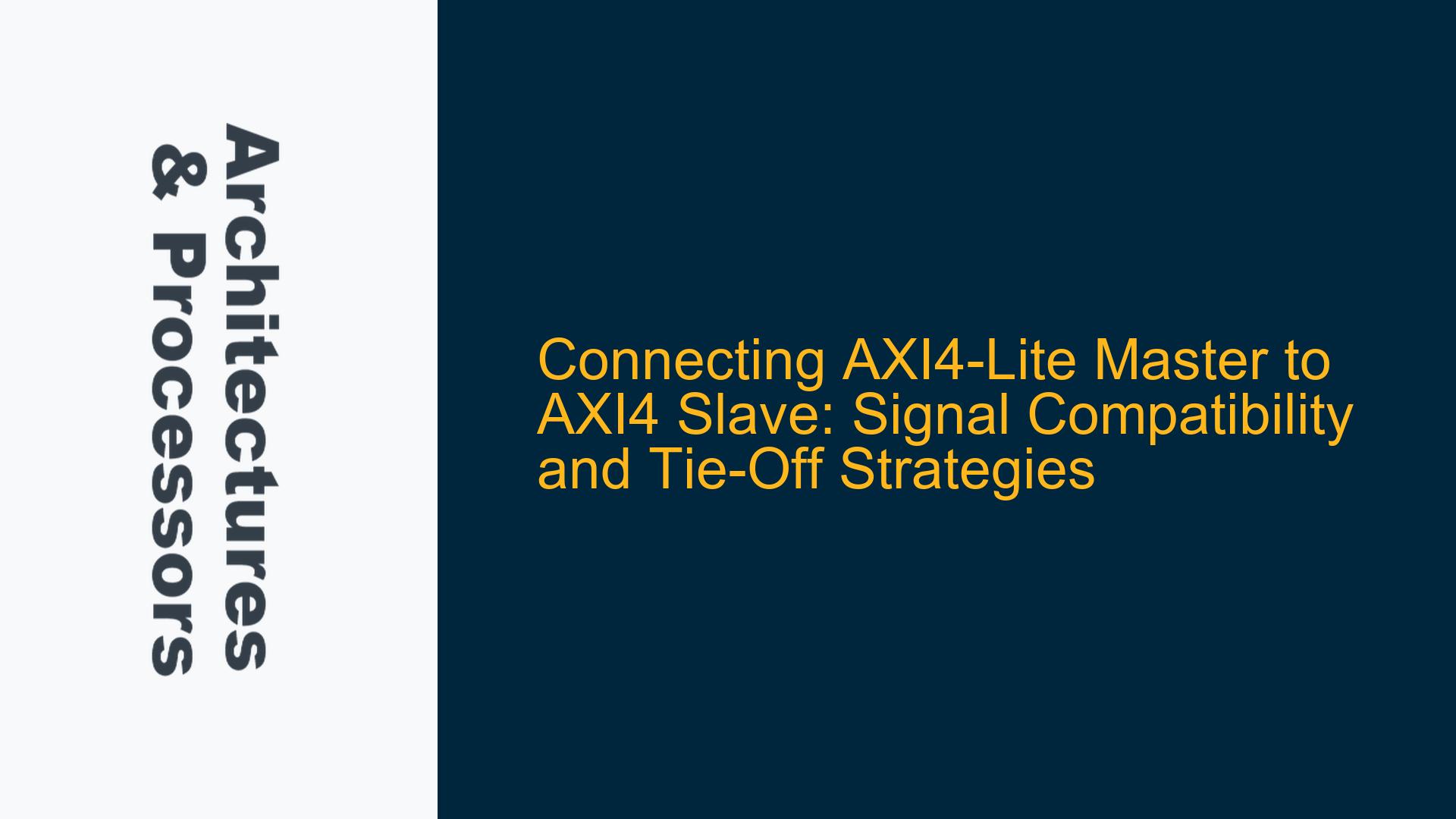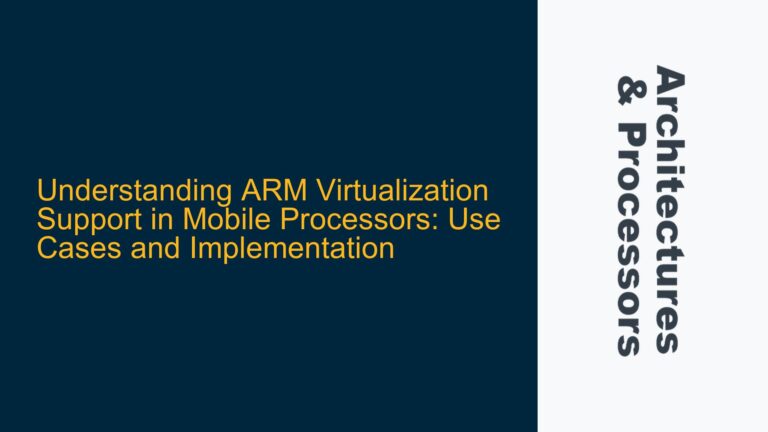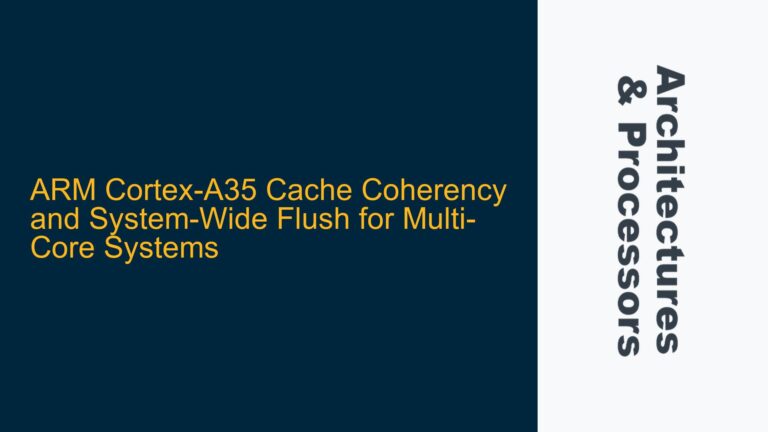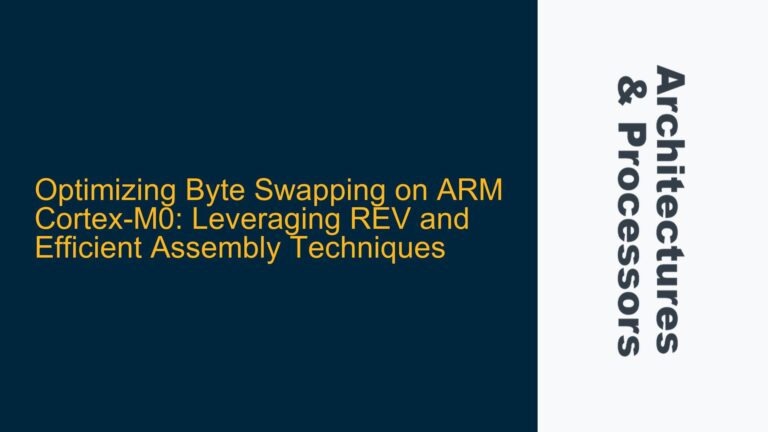AXI4-Lite Master and AXI4 Slave Signal Mismatch Challenges
The integration of an AXI4-Lite master with an AXI4 slave presents a unique set of challenges due to the inherent differences in their signal interfaces. AXI4-Lite is a simplified version of the AXI4 protocol, designed for low-complexity, low-power applications where advanced features such as burst transfers, out-of-order transactions, and exclusive accesses are not required. In contrast, AXI4 supports these advanced features, resulting in a more complex signal interface. The primary issue arises from the fact that the AXI4-Lite master lacks several signals that are present in the AXI4 slave interface. These signals include those related to burst length, transaction ID, burst type, and quality of service (QoS), among others.
The AXI4-Lite master interface typically includes only the essential signals required for basic read and write operations, such as address, data, and control signals. On the other hand, the AXI4 slave interface expects a more comprehensive set of signals to support the advanced features of the AXI4 protocol. This mismatch in signal availability necessitates careful consideration of how to handle the additional signals in the AXI4 slave interface when connecting it to an AXI4-Lite master.
The key signals that are present in the AXI4 slave but absent in the AXI4-Lite master include:
- AWID/ARID: These signals are used to identify transactions in a multi-master environment, allowing for out-of-order completion. AXI4-Lite does not support multiple outstanding transactions, so these signals are not required.
- AWLEN/ARLEN: These signals specify the number of transfers in a burst. AXI4-Lite supports only single transfers, so burst length is always one.
- AWSIZE/ARSIZE: These signals indicate the size of each transfer in a burst. AXI4-Lite transfers are always the full width of the data bus.
- AWBURST/ARBURST: These signals define the type of burst (e.g., fixed, incrementing). AXI4-Lite supports only single transfers, so burst type is not applicable.
- AWLOCK/ARLOCK: These signals are used for exclusive accesses. AXI4-Lite does not support exclusive accesses.
- AWCACHE/ARCACHE: These signals control cacheability and bufferability. AXI4-Lite transactions are typically non-cacheable and non-bufferable.
- AWQOS/ARQOS: These signals are used for QoS prioritization. AXI4-Lite does not support QoS.
- WLAST/RLAST: These signals indicate the last transfer in a burst. AXI4-Lite transfers are always single, so these signals are always high.
The absence of these signals in the AXI4-Lite master interface means that they must be handled appropriately when connecting to an AXI4 slave. This involves setting these signals to static values that are consistent with the AXI4-Lite protocol’s limitations and ensuring that the AXI4 slave can operate correctly with these constraints.
Signal Tie-Off and Default Value Configuration for AXI4-Lite to AXI4 Interfacing
To successfully connect an AXI4-Lite master to an AXI4 slave, it is essential to understand how to tie off or set default values for the signals that are present in the AXI4 slave but not in the AXI4-Lite master. This process involves configuring the AXI4 slave’s input signals to values that are compatible with the AXI4-Lite protocol’s limitations. The following sections detail the appropriate tie-off and default value configurations for each of the key signals.
AWID/ARID: Transaction ID Signals
The AWID and ARID signals are used in AXI4 to identify transactions, allowing for out-of-order completion and multiple outstanding transactions. Since AXI4-Lite does not support these features, these signals are not required. When connecting an AXI4-Lite master to an AXI4 slave, the AWID and ARID inputs on the slave should be tied to a static value. The specific value chosen is not critical, as the AXI4 slave will not use these signals for AXI4-Lite transactions. A common practice is to tie these signals to zero (e.g., AWID = 0, ARID = 0).
AWLEN/ARLEN: Burst Length Signals
The AWLEN and ARLEN signals specify the number of transfers in a burst. AXI4-Lite supports only single transfers, so the burst length is always one. Therefore, the AWLEN and ARLEN inputs on the AXI4 slave should be set to 8'b00000000, indicating a burst length of one transfer.
AWSIZE/ARSIZE: Transfer Size Signals
The AWSIZE and ARSIZE signals indicate the size of each transfer in a burst. AXI4-Lite transfers are always the full width of the data bus. For a 32-bit data bus, the AWSIZE and ARSIZE signals should be set to 3'b010 (indicating a 32-bit transfer). For a 64-bit data bus, these signals should be set to 3'b011 (indicating a 64-bit transfer).
AWBURST/ARBURST: Burst Type Signals
The AWBURST and ARBURST signals define the type of burst (e.g., fixed, incrementing). Since AXI4-Lite supports only single transfers, the burst type is not applicable. The AWBURST and ARBURST inputs on the AXI4 slave should be set to 2'b01, indicating an incrementing burst type. This is the simplest burst type and is consistent with the single-transfer nature of AXI4-Lite.
AWLOCK/ARLOCK: Lock Type Signals
The AWLOCK and ARLOCK signals are used for exclusive accesses, which are not supported by AXI4-Lite. Therefore, these signals should be tied to 1'b0, indicating that no exclusive accesses are being performed.
AWCACHE/ARCACHE: Memory Type Signals
The AWCACHE and ARCACHE signals control cacheability and bufferability. AXI4-Lite transactions are typically non-cacheable and non-bufferable. Therefore, these signals should be set to 4'b0000, indicating non-modifiable, non-bufferable transactions.
AWQOS/ARQOS: Quality of Service Signals
The AWQOS and ARQOS signals are used for QoS prioritization, which is not supported by AXI4-Lite. These signals can be set to a static value, such as 4'b0000, indicating the default QoS level. Alternatively, if the AXI4 slave is part of a system with multiple masters, these signals can be set to a value that reflects the priority of the AXI4-Lite master relative to other masters in the system.
WLAST/RLAST: Last Transfer Signals
The WLAST and RLAST signals indicate the last transfer in a burst. Since AXI4-Lite supports only single transfers, the WLAST signal should be set to 1'b1 for every write transaction, indicating that the transfer is the last (and only) in the burst. The RLAST signal from the AXI4 slave can be ignored, as the AXI4-Lite master will always expect a single transfer in response to a read request.
Implementing Signal Tie-Off and Verification Strategies
Once the appropriate tie-off and default value configurations have been determined, the next step is to implement these configurations in the design and verify that the AXI4-Lite master and AXI4 slave can communicate correctly. This involves both RTL implementation and verification using simulation environments.
RTL Implementation of Signal Tie-Off
In the RTL design, the additional signals on the AXI4 slave interface that are not present in the AXI4-Lite master must be tied off to their respective default values. This can be done using constant assignments in the RTL code. For example, in VHDL, the signals can be tied off as follows:
i_s_axi_awid <= (others => '0'); -- Tie AWID to 0
i_s_axi_awlen <= "00000000"; -- Set AWLEN to 0 (single transfer)
i_s_axi_awsize <= "010"; -- Set AWSIZE to 32-bit transfer
i_s_axi_awburst <= "01"; -- Set AWBURST to INCR
i_s_axi_awlock <= '0'; -- Tie AWLOCK to 0
i_s_axi_awcache <= "0000"; -- Set AWCACHE to non-modifiable, non-bufferable
i_s_axi_awqos <= "0000"; -- Set AWQOS to default
i_s_axi_wlast <= '1'; -- Set WLAST to 1 (single transfer)
Similar assignments should be made for the read channel signals (ARID, ARLEN, ARSIZE, ARBURST, ARLOCK, ARCACHE, ARQOS).
Verification of Signal Tie-Off and Communication
Verification of the signal tie-off and communication between the AXI4-Lite master and AXI4 slave is critical to ensure that the design functions correctly. This can be achieved using a combination of directed tests and constrained random tests in a simulation environment.
Directed Tests
Directed tests should be written to verify that the AXI4-Lite master can successfully perform read and write transactions with the AXI4 slave. These tests should cover the following scenarios:
- Single read and write transactions to different addresses.
- Verification that the AXI4 slave correctly handles the tied-off signals (e.g., AWID, AWLEN, AWSIZE, etc.).
- Verification that the AXI4 slave responds with the correct RLAST signal for read transactions.
Constrained Random Tests
Constrained random tests can be used to stress-test the interface by generating a large number of random transactions. These tests should cover a wide range of address and data values, as well as different combinations of control signals. The goal is to ensure that the AXI4 slave can handle any valid transaction generated by the AXI4-Lite master, even under random conditions.
Assertion-Based Verification
Assertions can be used to monitor the behavior of the AXI4 slave and ensure that it adheres to the AXI4 protocol. For example, assertions can be written to check that the RLAST signal is always high for read transactions, or that the AWLEN signal is always zero for write transactions. These assertions can help catch protocol violations early in the verification process.
Debugging and Troubleshooting
During the verification process, it is important to monitor the behavior of both the AXI4-Lite master and the AXI4 slave to identify any issues. Common issues that may arise include:
- Incorrect Signal Tie-Off: If the signals are not tied off correctly, the AXI4 slave may misinterpret the transactions, leading to incorrect behavior. For example, if the AWLEN signal is not set to zero, the AXI4 slave may attempt to perform a burst transfer, which is not supported by AXI4-Lite.
- Protocol Violations: The AXI4 slave may violate the AXI4 protocol if it does not handle the tied-off signals correctly. For example, if the RLAST signal is not asserted for a read transaction, the AXI4-Lite master may hang waiting for the transaction to complete.
- Timing Issues: Timing issues may arise if the AXI4 slave does not respond to transactions within the expected time frame. This can be particularly problematic in systems with multiple masters, where the AXI4-Lite master may need to compete for access to the slave.
To debug these issues, it is important to use simulation tools that provide visibility into the internal signals of both the AXI4-Lite master and the AXI4 slave. Waveform viewers can be used to trace the flow of transactions and identify where the protocol is being violated. Additionally, logging and reporting tools can be used to capture and analyze the behavior of the system over time.
Conclusion
Connecting an AXI4-Lite master to an AXI4 slave requires careful consideration of the signal differences between the two protocols. By understanding the limitations of AXI4-Lite and appropriately tying off the additional signals in the AXI4 slave interface, it is possible to achieve successful communication between the two. Verification is critical to ensure that the design functions correctly, and a combination of directed tests, constrained random tests, and assertion-based verification can be used to achieve this goal. With proper implementation and verification, the AXI4-Lite master and AXI4 slave can work together seamlessly, enabling the development of efficient and reliable ARM-based SoCs.






